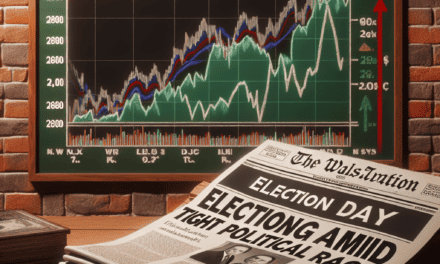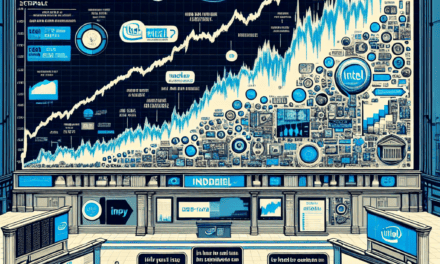“Gold Dips as Dollar Dominates: Market Reacts to Trump Triumph”
Introduction
Gold prices have approached a seven-week low as the U.S. dollar surged in the wake of Donald Trump’s victory in the presidential election. The unexpected outcome has led to significant market volatility, with investors flocking to the dollar as a safe haven, thereby diminishing the appeal of gold. This shift reflects broader market dynamics and investor sentiment, as the strengthening dollar typically exerts downward pressure on gold prices. The current trend underscores the complex interplay between political events and financial markets, highlighting gold’s sensitivity to currency fluctuations and geopolitical developments.
Impact Of Dollar Surge On Gold Prices
In the wake of Donald Trump’s unexpected victory in the 2016 U.S. presidential election, financial markets have experienced significant volatility, with one of the most notable impacts being the surge of the U.S. dollar. This surge has, in turn, exerted downward pressure on gold prices, which have approached a seven-week low. Understanding the relationship between the dollar’s strength and gold prices is crucial for investors and market analysts alike, as it provides insights into broader economic trends and potential future movements in these markets.
The U.S. dollar’s strength is often inversely related to gold prices. When the dollar appreciates, gold becomes more expensive for holders of other currencies, leading to a decrease in demand. This inverse relationship is a fundamental principle in the commodities market, where gold is often seen as a hedge against currency fluctuations and economic uncertainty. In the current scenario, the dollar’s surge can be attributed to several factors, including expectations of increased fiscal spending, tax cuts, and deregulation under the Trump administration. These anticipated policies have fueled optimism about economic growth, prompting investors to flock to the dollar as a safe haven.
As the dollar strengthens, gold’s appeal diminishes, leading to a decline in its price. This trend has been evident in the weeks following the election, as investors reassess their portfolios in light of the new political landscape. The prospect of higher interest rates, which the Federal Reserve has hinted at in response to potential inflationary pressures from Trump’s proposed policies, further compounds the situation. Higher interest rates increase the opportunity cost of holding non-yielding assets like gold, making them less attractive to investors seeking returns.
Moreover, the global economic context plays a significant role in shaping the dynamics between the dollar and gold. In times of geopolitical uncertainty or economic instability, gold is traditionally viewed as a safe-haven asset. However, the current environment, characterized by a strong dollar and expectations of robust U.S. economic performance, has shifted investor sentiment away from gold. This shift is evident in the outflows from gold-backed exchange-traded funds (ETFs), which have seen a decline as investors pivot towards assets that benefit from a stronger dollar and rising interest rates.
Despite the current downward trend in gold prices, it is essential to consider the potential for future fluctuations. The global economic landscape remains complex, with factors such as Brexit negotiations, trade tensions, and geopolitical risks continuing to influence market dynamics. These uncertainties could lead to renewed interest in gold as a hedge against potential market disruptions. Additionally, any deviation from the anticipated policy trajectory of the Trump administration could alter investor expectations and impact both the dollar and gold prices.
In conclusion, the recent surge in the U.S. dollar following Donald Trump’s election victory has had a pronounced impact on gold prices, driving them to a seven-week low. This development underscores the intricate relationship between currency strength and commodity prices, highlighting the importance of understanding these dynamics for investors and market participants. As the global economic environment continues to evolve, keeping a close eye on policy developments and geopolitical events will be crucial in anticipating future movements in the dollar and gold markets.
Historical Analysis Of Gold Price Fluctuations Post-Election
The aftermath of presidential elections in the United States has historically been a period of significant volatility for financial markets, with gold prices often experiencing notable fluctuations. The recent decline in gold prices, reaching a seven-week low, can be attributed to the surge in the U.S. dollar following Donald Trump’s victory in the presidential election. This phenomenon is not unprecedented; rather, it aligns with historical patterns observed in the behavior of gold prices in response to political events and shifts in market sentiment.
To understand the current situation, it is essential to examine the historical context of gold price movements in the wake of U.S. elections. Traditionally, gold is perceived as a safe-haven asset, attracting investors during times of uncertainty and economic instability. However, the relationship between gold prices and election outcomes is complex and influenced by a myriad of factors, including changes in fiscal policy, geopolitical tensions, and currency fluctuations.
In the case of Trump’s election, the immediate market reaction was characterized by a strengthening of the U.S. dollar. This appreciation of the dollar can be attributed to expectations of increased fiscal spending, tax reforms, and deregulation, which were central themes of Trump’s campaign. A stronger dollar typically exerts downward pressure on gold prices, as gold is priced in dollars and becomes more expensive for foreign investors when the dollar appreciates.
Historically, similar patterns have been observed in previous election cycles. For instance, following the election of Ronald Reagan in 1980, gold prices initially declined as the dollar strengthened in response to anticipated economic reforms. However, it is important to note that while short-term fluctuations are common, the long-term trajectory of gold prices is often influenced by broader economic trends and monetary policy decisions.
Moreover, the interplay between gold prices and interest rates is a critical factor to consider. The prospect of rising interest rates, which often accompanies a strengthening economy, can further impact gold prices. Higher interest rates increase the opportunity cost of holding non-yielding assets like gold, leading to potential declines in demand. In the current scenario, market participants are closely monitoring the Federal Reserve’s monetary policy stance, as any indication of rate hikes could exert additional pressure on gold prices.
Despite these immediate reactions, it is crucial to recognize that gold’s role as a hedge against inflation and currency devaluation remains a significant consideration for investors. In the long term, factors such as global economic growth, inflationary pressures, and geopolitical uncertainties will continue to shape the demand for gold. Therefore, while the current decline in gold prices may be attributed to the dollar’s surge post-election, the broader context of economic fundamentals and market dynamics will ultimately determine the future trajectory of gold.
In conclusion, the recent drop in gold prices following Trump’s election victory is consistent with historical patterns observed in the aftermath of U.S. elections. The strengthening of the U.S. dollar, driven by expectations of economic policy changes, has played a pivotal role in this decline. However, as history has shown, the long-term outlook for gold is influenced by a complex interplay of factors, including interest rates, inflation, and geopolitical developments. As such, investors should remain vigilant and consider these broader trends when assessing the potential impact on gold prices in the future.
Factors Contributing To Gold’s Seven-Week Low
In the wake of Donald Trump’s unexpected victory in the 2016 U.S. presidential election, the financial markets have experienced significant volatility, with gold prices approaching a seven-week low. This decline in gold can be attributed to a confluence of factors, primarily driven by the surge in the U.S. dollar and shifting investor sentiment. As the dollar strengthens, it exerts downward pressure on gold prices, given that gold is priced in dollars and becomes more expensive for holders of other currencies. Consequently, the inverse relationship between the dollar and gold is a critical factor in understanding the recent dip in gold prices.
Moreover, the anticipation of potential policy changes under the Trump administration has further influenced market dynamics. Investors are speculating on the possibility of increased fiscal spending, tax cuts, and deregulation, which could stimulate economic growth and lead to higher interest rates. Higher interest rates tend to diminish the appeal of non-yielding assets like gold, as investors seek better returns elsewhere. This expectation of rising interest rates has contributed to the strengthening of the dollar, thereby exacerbating the downward pressure on gold.
In addition to these macroeconomic factors, market sentiment has played a pivotal role in the recent movements of gold prices. Following the election, there was a notable shift in investor sentiment, with a move towards riskier assets such as equities. This shift was driven by optimism about potential economic growth under the new administration, leading to a reallocation of funds away from safe-haven assets like gold. As investors reassess their portfolios in light of the changing political landscape, the demand for gold as a hedge against uncertainty has diminished, further contributing to its price decline.
Furthermore, the global economic context cannot be overlooked when analyzing the factors affecting gold prices. The international markets have been closely monitoring the U.S. election and its implications for global trade and economic policies. The potential for renegotiated trade agreements and protectionist measures has introduced an element of uncertainty, which typically supports gold prices. However, the immediate reaction has been a focus on the domestic economic implications, overshadowing the global uncertainties for the time being.
It is also important to consider the role of central banks in this scenario. The Federal Reserve’s monetary policy decisions are closely watched by investors, as they have a direct impact on interest rates and, consequently, on gold prices. The prospect of a rate hike in the near future has been a topic of discussion, and any indication of tightening monetary policy could further strengthen the dollar, putting additional pressure on gold.
In conclusion, the approach of gold towards a seven-week low is the result of a complex interplay of factors, including the surge in the U.S. dollar, expectations of economic policy changes under the Trump administration, shifts in investor sentiment, and the broader global economic context. As these elements continue to evolve, they will undoubtedly influence the trajectory of gold prices in the coming weeks and months. Investors and analysts alike will be closely monitoring these developments, seeking to navigate the uncertainties and opportunities presented by this dynamic financial landscape.
The Relationship Between Political Events And Commodity Markets
The intricate relationship between political events and commodity markets is a subject of perennial interest to economists, investors, and policymakers alike. The recent decline in gold prices, reaching a seven-week low, serves as a compelling case study in this dynamic interplay. This downturn in gold’s value coincides with a significant surge in the U.S. dollar, a development that followed the unexpected victory of Donald Trump in the presidential election. To understand this phenomenon, it is essential to explore the underlying mechanisms that connect political events to fluctuations in commodity markets.
Political events, particularly those of significant magnitude, often lead to uncertainty in financial markets. This uncertainty can manifest in various ways, influencing investor behavior and, consequently, the prices of commodities. In the case of gold, a commodity traditionally viewed as a safe-haven asset, political instability or unexpected political outcomes typically drive investors to seek refuge in its perceived stability. However, the recent U.S. election results have defied this conventional wisdom, as evidenced by the decline in gold prices.
The key to understanding this anomaly lies in the concurrent rise of the U.S. dollar. Following Trump’s victory, market participants anticipated a shift in economic policy, with expectations of increased fiscal spending, tax cuts, and deregulation. These anticipated policy changes fueled optimism about economic growth, leading to a rally in the stock market and a strengthening of the dollar. As the dollar appreciates, gold, which is priced in dollars, becomes more expensive for foreign investors, thereby reducing its attractiveness and contributing to its price decline.
Moreover, the relationship between the dollar and gold is often inversely correlated. A stronger dollar typically exerts downward pressure on gold prices, as it diminishes the purchasing power of other currencies. This inverse relationship was particularly pronounced in the aftermath of the election, as investors recalibrated their portfolios in response to the anticipated economic policies of the incoming administration. The expectation of higher interest rates, driven by potential inflationary pressures from increased government spending, further bolstered the dollar’s appeal, compounding the downward trajectory of gold.
In addition to these economic factors, market sentiment plays a crucial role in shaping commodity prices. The election outcome, while unexpected, was interpreted by many investors as a harbinger of pro-business policies that could stimulate economic growth. This sentiment shift prompted a reallocation of assets, with investors moving away from safe-haven assets like gold and towards riskier investments such as equities. The resultant capital flows further exacerbated the decline in gold prices.
While the immediate impact of political events on commodity markets can be significant, it is important to recognize that these effects are often transient. As the initial shock subsides and markets adjust to new realities, the fundamental drivers of commodity prices, such as supply and demand dynamics, reassert their influence. In the case of gold, factors such as geopolitical tensions, inflation expectations, and central bank policies will continue to play a pivotal role in determining its long-term trajectory.
In conclusion, the recent decline in gold prices amid a surging dollar following Trump’s election victory underscores the complex interplay between political events and commodity markets. By examining the economic and psychological factors at play, one gains a deeper understanding of how political developments can influence investor behavior and commodity prices. As markets continue to evolve, the relationship between politics and commodities will remain a critical area of study for those seeking to navigate the ever-changing financial landscape.
Investor Reactions To Trump Victory And Market Volatility
In the wake of Donald Trump’s unexpected victory in the 2016 U.S. presidential election, global financial markets have experienced significant volatility, with investors scrambling to reassess their strategies in light of the new political landscape. One of the most notable market reactions has been the sharp decline in gold prices, which have approached a seven-week low. This downturn in gold, traditionally seen as a safe-haven asset, can be attributed to the concurrent surge in the U.S. dollar, as investors anticipate potential economic policies under the Trump administration that could bolster the American economy.
Initially, the election results sent shockwaves through the markets, with many investors seeking refuge in gold amid uncertainty. However, as the dust began to settle, a shift in sentiment occurred. The U.S. dollar began to strengthen significantly, driven by expectations of increased fiscal spending, tax cuts, and deregulation promised by Trump during his campaign. These anticipated policies have led to speculation that the Federal Reserve might accelerate its pace of interest rate hikes, further enhancing the dollar’s appeal. As a result, the opportunity cost of holding non-yielding assets like gold has increased, prompting a sell-off in the precious metal.
Moreover, the strengthening dollar has made gold more expensive for holders of other currencies, dampening demand on a global scale. This inverse relationship between the dollar and gold is a well-established dynamic in financial markets, and it has been particularly pronounced in the aftermath of the election. Investors, therefore, have been recalibrating their portfolios, moving away from gold and towards assets that are expected to benefit from a robust U.S. economy.
In addition to the dollar’s rise, the equity markets have also reacted positively to Trump’s victory, further diminishing gold’s allure. The prospect of pro-business policies has fueled a rally in stock markets, with investors optimistic about potential growth opportunities. This shift towards equities has been another factor contributing to the decline in gold prices, as investors seek higher returns in a potentially expanding economy.
However, it is important to note that while the immediate reaction has been a move away from gold, the long-term implications of Trump’s presidency remain uncertain. Geopolitical risks, trade policies, and international relations could still play a significant role in shaping market dynamics. As such, some investors may continue to view gold as a strategic asset for diversification and risk management, particularly if global uncertainties resurface.
In conclusion, the investor reactions to Trump’s victory have been multifaceted, with the surge in the U.S. dollar and the rally in equity markets leading to a notable decline in gold prices. While the current sentiment favors a stronger dollar and equities, the evolving political and economic landscape under the Trump administration will likely continue to influence market volatility. Investors will need to remain vigilant, adapting their strategies as new information emerges and as the long-term effects of Trump’s policies become clearer. As always, the interplay between currency movements, interest rates, and geopolitical developments will be crucial in determining the future trajectory of gold and other financial assets.
Long-Term Implications Of A Strong Dollar On Precious Metals
The recent surge in the U.S. dollar, catalyzed by Donald Trump’s unexpected victory in the presidential election, has sent ripples through global financial markets, notably impacting the precious metals sector. Gold, often perceived as a safe-haven asset, has approached a seven-week low, reflecting the complex interplay between currency strength and commodity prices. This development prompts a closer examination of the long-term implications of a robust dollar on precious metals, particularly gold.
To begin with, the relationship between the U.S. dollar and gold is historically inverse. When the dollar strengthens, gold prices typically decline, as a stronger dollar makes gold more expensive for holders of other currencies, thereby reducing demand. The recent appreciation of the dollar can be attributed to market optimism regarding potential economic policies under the Trump administration, such as tax cuts and increased infrastructure spending, which are anticipated to stimulate economic growth. Consequently, investors have flocked to the dollar, perceiving it as a more attractive investment relative to gold.
Moreover, the Federal Reserve’s monetary policy plays a crucial role in this dynamic. With the dollar gaining strength, the likelihood of interest rate hikes by the Federal Reserve increases. Higher interest rates tend to bolster the dollar further, as they offer better returns on investments denominated in the currency. This scenario poses a challenge for gold, which does not yield interest or dividends, making it less appealing in a high-interest-rate environment. As a result, investors may continue to favor the dollar over gold, exerting downward pressure on gold prices.
In addition to these immediate effects, the long-term implications of a strong dollar on precious metals are multifaceted. A sustained period of dollar strength could lead to structural shifts in global trade and investment patterns. For instance, countries with significant gold reserves may reassess their holdings, opting to diversify into other assets that offer better returns in a strong dollar environment. This could lead to a reallocation of resources away from gold, further impacting its price.
Furthermore, the geopolitical landscape could also influence the long-term outlook for precious metals. A strong dollar often correlates with increased U.S. economic and political influence globally. This could lead to shifts in international alliances and trade agreements, potentially affecting the demand for gold as a hedge against geopolitical uncertainty. In such a scenario, gold’s role as a safe-haven asset may be diminished, as investors seek alternative strategies to mitigate risk.
However, it is essential to consider that the relationship between the dollar and gold is not solely deterministic. Other factors, such as inflation expectations, geopolitical tensions, and changes in technology and production costs, can also significantly impact gold prices. For instance, if inflation were to rise unexpectedly, gold might regain its appeal as a hedge against currency devaluation, even in the face of a strong dollar.
In conclusion, while the immediate impact of a surging dollar has been a decline in gold prices, the long-term implications are more nuanced. The interplay between monetary policy, global economic conditions, and geopolitical factors will continue to shape the outlook for precious metals. Investors and policymakers alike must remain vigilant, considering both the direct and indirect effects of a strong dollar on the precious metals market. As the global economic landscape evolves, so too will the dynamics between currency strength and commodity prices, necessitating a comprehensive understanding of these complex relationships.
Strategies For Investors During Periods Of Market Uncertainty
In the wake of Donald Trump’s unexpected victory in the 2016 U.S. presidential election, financial markets have experienced significant volatility, with gold prices approaching a seven-week low. This decline in gold, traditionally seen as a safe-haven asset, can be attributed to the concurrent surge in the U.S. dollar. As investors navigate this period of market uncertainty, it is crucial to adopt strategies that can mitigate risk while capitalizing on potential opportunities.
To begin with, diversification remains a fundamental strategy for investors during uncertain times. By spreading investments across various asset classes, sectors, and geographical regions, investors can reduce the impact of volatility in any single market. For instance, while gold prices may be declining, other commodities or equities in different sectors might be experiencing growth. This balanced approach can help stabilize a portfolio’s overall performance.
Moreover, maintaining a long-term perspective is essential. Market fluctuations are inevitable, and reacting impulsively to short-term movements can lead to suboptimal decisions. Instead, investors should focus on their long-term financial goals and remain committed to their investment plans. Historical data suggests that markets tend to recover over time, and those who stay the course are often rewarded.
In addition to diversification and a long-term outlook, investors should consider the role of asset allocation in their strategies. Adjusting the proportion of stocks, bonds, and other assets in a portfolio can help manage risk according to an individual’s risk tolerance and investment horizon. For example, during periods of heightened uncertainty, increasing the allocation to bonds or other fixed-income securities might provide more stability and income.
Furthermore, it is important for investors to stay informed about macroeconomic trends and geopolitical developments. Understanding the broader economic landscape can provide valuable insights into potential market movements. In the current scenario, the strengthening of the U.S. dollar following Trump’s victory has implications for global trade and investment flows. By keeping abreast of such developments, investors can make more informed decisions about their portfolios.
Another strategy to consider is the use of hedging techniques to protect against downside risk. Instruments such as options and futures can be employed to offset potential losses in other parts of a portfolio. While these tools can be complex and may not be suitable for all investors, they offer a way to manage risk in volatile markets.
Additionally, maintaining liquidity is a prudent approach during uncertain times. Having access to cash or cash-equivalent assets allows investors to take advantage of opportunities that may arise from market dislocations. It also provides a buffer to meet any unexpected financial needs without having to liquidate long-term investments at a loss.
Finally, consulting with financial advisors or investment professionals can provide valuable guidance tailored to individual circumstances. These experts can offer insights into market trends, recommend appropriate strategies, and help investors navigate the complexities of uncertain markets.
In conclusion, while the current market environment presents challenges, it also offers opportunities for those who are prepared. By employing strategies such as diversification, maintaining a long-term perspective, adjusting asset allocation, staying informed, using hedging techniques, maintaining liquidity, and seeking professional advice, investors can better position themselves to weather periods of market uncertainty and achieve their financial objectives.
Q&A
1. **Question:** What event caused gold prices to approach a seven-week low?
– **Answer:** The victory of Donald Trump in the U.S. presidential election.
2. **Question:** How did the U.S. dollar perform following Trump’s victory?
– **Answer:** The U.S. dollar surged following Trump’s victory.
3. **Question:** What is the relationship between the U.S. dollar and gold prices?
– **Answer:** Generally, a stronger U.S. dollar leads to lower gold prices because gold is priced in dollars, making it more expensive for foreign buyers.
4. **Question:** What was the market’s initial reaction to Trump’s victory in terms of gold prices?
– **Answer:** Initially, gold prices spiked due to uncertainty and market volatility.
5. **Question:** Why did gold prices eventually decline after the initial spike?
– **Answer:** Gold prices declined as the U.S. dollar strengthened and market fears subsided.
6. **Question:** How do investors typically view gold during times of political uncertainty?
– **Answer:** Investors often view gold as a safe-haven asset during times of political uncertainty.
7. **Question:** What other factors, besides the dollar’s strength, can influence gold prices?
– **Answer:** Other factors include interest rates, inflation expectations, geopolitical tensions, and overall economic conditions.
Conclusion
Gold prices have recently approached a seven-week low, primarily driven by a surge in the U.S. dollar following Donald Trump’s victory in the presidential election. The strengthening dollar has made gold more expensive for holders of other currencies, leading to decreased demand and a subsequent drop in gold prices. This trend reflects investor confidence in the U.S. economy under the new administration, as well as expectations of potential interest rate hikes by the Federal Reserve, which further supports the dollar. As a result, gold, typically seen as a safe-haven asset, has experienced downward pressure in the face of a robust dollar and shifting market dynamics.





